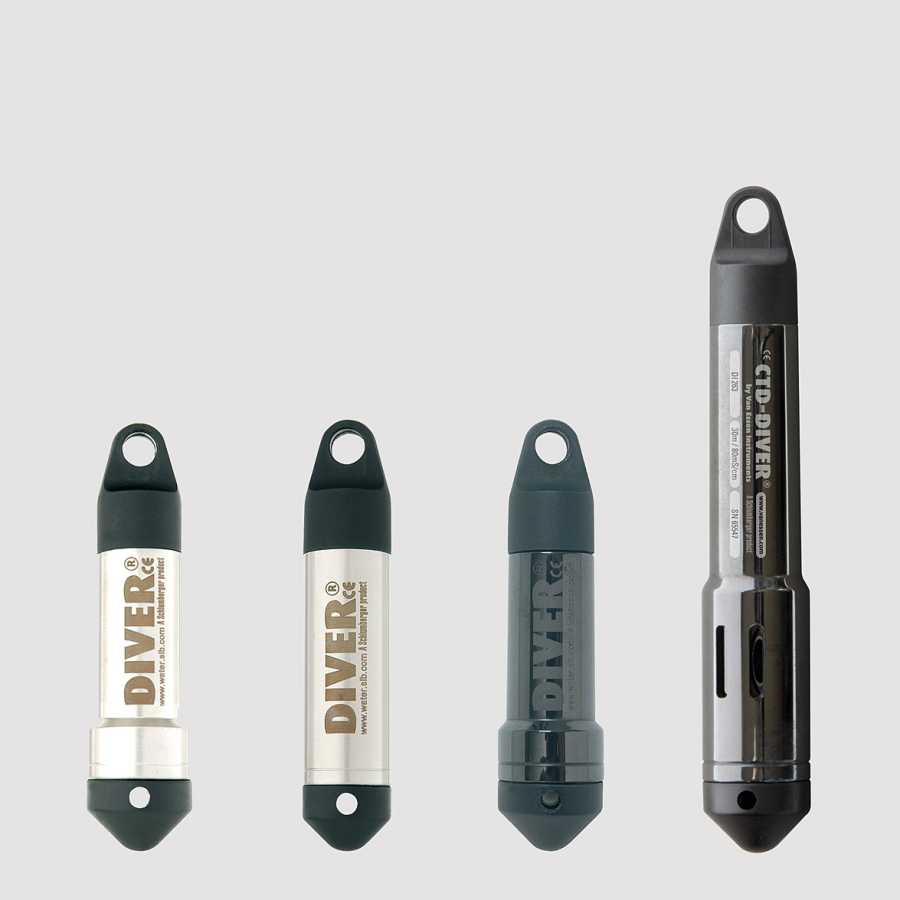Datalogger
Data loggers are elongated devices that can be hung in a monitoring well. They can measure the groundwater at various times over a longer period of time. Depending on the data loggers, different (combinations) of parameters of the groundwater can be measured. After a certain period, the data loggers can be removed from the monitoring well and the measurements can be transferred via a cable to a computer for further processing and interpretation, or read out telemetrically via a GSM modem or bluetooth.
| General information | ||
| Name | data logger. A specific version is the diver. | |
| Unit of measure and parameter | Pressure in cm H 2 O. temperature in 0 C. EC in mS/cm (depending on type). | |
| Soil phase | groundwater | |
| Nature technique | Physical, chemical or probe/sensor | |
| Place of application | in situ | |
| Detection Mode | Measurement at ground level / water bottom or on surface of open water | |
| Applicable in separate layers | Yes with a minimum layer thickness of 1 m | |
| Soil types for which technology is suitable |
| |
| Land soil/water bottom | land soil and water bottom | |
| Step in the data collection chain | Sampling, measure or data collection and evaluation | |
| Moment of availability results | Measurement results are available in the field | |
| Technology development phase | widening phase or applied routinely | |
| Method of purchasing | as service, as a product or as a device | |
| General description of the implementation method | The data logger is suspended in a monitoring well. Measurements are taken at a preset time interval and stored in the memory of the data logger. At the end of the period, all data is read out with a computer. The following techniques are available for reading the data logger without first removing it from the monitoring well:
| |
| Working principle | The data logger is a pressure transducer in which some versions can also measure parameters such as temperature, EC or oxygen content. After programming, the data logger is suspended in a monitoring well. To derive groundwater levels, the use of a so-called 'baro-logger' is necessary. The baro-logger measures the air pressure. With the data from the baro-logger, the measurements of the ordinary data loggers are corrected for air pressure variations (the ordinary data logger measures the air pressure + the pressure of the water column above the data logger). Some data loggers have built-in baro loggers. After a certain period (depending on the nature and purpose of the assignment and the selected measurement frequency), the data is read from the data logger. A data logger can also be used to perform surface water level measurements. | |
| Point / line measurement / volume measurement | Point measurement | |
| Typical depth range | 0 - 300 m and the sensitivity is independent of depth | |
| Time properties | A data logger can be hung in a monitoring well for a longer period of time (eg monthly, quarterly or half yearly). The data logger can be programmed with which time interval measurements should be performed and stored. Setting and reading a data logger can take place within 1 hour. Measurement frequency can be preset (between 0.5 sec and 99 hours). | |
| Measuring rate | Measurement data can be read immediately after the measurement. | |
| Presentation results | With the accompanying software, the results can be viewed directly in the field. | |
| Cost | - Standard data logger: approximately €500 - Baro logger: approximately € 350 - Cost of field investigation (including placing monitoring well, driving costs and installing data logger) | |
| Trends and developments | Read out data via bluetooth. | |
| User information | ||
| Availability | one or a few providers in NL | |
| Is technology often used? | Very organized | |
| Research phase in which technology can be applied | Explore, map out, variant selection, design, realization, check, monitoring and aftercare | |
| Verification measurements / calibration measurements | are often used | |
| Frequently used application in practice | Various projects where groundwater levels/quality must be recorded for a longer period of time or with a relatively high measuring frequency, such as:
| |
| Suitability | In all soil layers, provided that a monitoring well is present with good flow | |
| Practical experiences in the Netherlands | Data loggers are regularly used by various parties (including municipalities, water boards, provinces, water companies and research and engineering firms) | |
| “Dos“ | Before installing and retrieving a data logger, perform a manual measurement of the groundwater level. Measure the height at the top of the monitoring well in relation to NAP. Measuring and registering the depth at which the data logger hangs. Water pressure correction for air pressure variances. | |
| “Don'ts” | Hang data logger too shallow (data logger falls dry) Hang data logger too deep (note measuring range!) | |
| Also suitable for | Measuring surface water levels. | |
References
Contents
